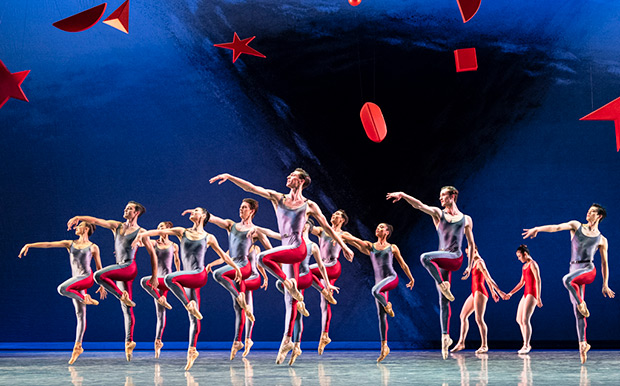
© Foteini Christofilopoulou. (Click image for larger version)
San Francisco Ballet
Shostakovich Trilogy – Symphony #9, Chamber Symphony, Piano Concerto #1
★★★★✰
London, Sadler’s Wells
29 May 2019
Gallery of pictures by Foteini Christofilopoulou
www.sfballet.org
www.sadlerswells.com
Back in 2014 I had the pleasure of interviewing San Francisco Ballet principals Yuan Yuan Tan and Tiit Helimets about their upcoming performances at that year’s Les Etés de la Danse Festival in Paris. One of the ballets on the menu was Alexei Ratmansky’s Piano Concerto #1, the third instalment of the Russian dancemaker’s Shostakovich Trilogy, which SFB debuted in 2014 and recently brought to London for its UK premiere. Helimets had just learned Concerto and deemed it “amazing. It really pushes the boundaries of human movement.”

© Foteini Christofilopoulou. (Click image for larger version)
The same could be said of the trilogy at large. Shown together, these standalone half-hour ballets – each set to a Shostakovich composition – form a gleaming triptych of imaginative and remarkably demanding choreography. The production is textured in every aspect, plumbing deep wells of emotion and revelling in a multiplicity of tones, tempers and movement styles. Ratmansky achieves all this without a plot, instead turning his attention to dissecting the nuances of the music, teasing out its emotive stories – chronicles of grief and triumph, elegies of desolation and bliss. Shostakovich created much of his work under the constraints of Soviet regime, and the compositions on show here reflect the turbulence of this time period in impassioned, often dissonant swerves. Under Robert Gibbs’ direction, the Royal Ballet Sinfonia does a great service to the scores at hand, capturing their volatility in violins, cellos and bassoons, nervy flutes and a gallant brass section.

© Foteini Christofilopoulou. (Click image for larger version)
We start with Symphony #9, a buoyant montage of tango-style lunges, glossy glissades and lashings of ballon. Both the music and the choreography reference the Soviet victory over Nazi Germany, with whiffs of darkness unsettling their sunny exteriors. The dancers march like guardsmen, thump like dissidents, scamper like civilians. I’m struck by the wit of the formations – which don’t assemble so much as blossom – and by the unpredictably of the ensemble as they motor between such diverse qualities of motion. One minute we’re nodding along to Balanchinean dives into the wings; the next we’re craning to see a quartet cradle a crumpled soul. Aaron Robison is a suave central figure, marking his pathos with supple contractions. Wei Wang is sharper, more strapping, delivering pin-sharp petit allegro and drawing cheers from the stalls with his flawless grand pirouettes.

© Foteini Christofilopoulou. (Click image for larger version)
The tense timbre of Chamber Symphony greets us after the first interval. It’s the most melancholy of the three scores, and the most personal, sketching an edgy uncertainty that hints at relationships scuppered and fears realised. Against a backdrop of doleful Dadaist faces, a black-suited Ulrik Birkkjaer stretches his hands to the sky. His distress – and later, hope – is intensified in duets with three women in watercolour skirts, including veteran principal Yuan Yuan Tan, whose molten frame and textbook turnout command the surrounding action to a standstill. Occasionally Birkkjaer’s partners collapse their pliés, lying limp as ragdolls at his feet; at other points, he’s the one who needs picking up. There are some monumental formations in this section, including a cascade of pastel ballerinas whisked and dipped in rippling succession. Another striking moment sees Mathilde Froustey pitched weightlessly among a group of men.

© Foteini Christofilopoulou. (Click image for larger version)
The buoyancy returns for Piano Concerto #1, although this time around it’s a more velvety bounce, with slick stag leaps and twirling lifts. The mise en scene is a feast of reds: a cherry mobile dangles from the rafters; the soloists gleam in ruby Lycra; the ensemble’s unitards flash peeks of crimson, Louboutin-style. Just as trumpets blast overtop silky keys in this composition, shuddering limbs detonate amid ripples of sleek prancing. Sofiane Sylva shines in an exquisite opening phrase, coiling her torso as her companions clutch her like a precious piece of art. There are a couple slip-ups in the kaleidoscopic promenades and circus-style tableaux, but nothing that undoes the fascinating work before us.

© Foteini Christofilopoulou. (Click image for larger version)
The production, one of four programmes showing during SFB’s whirlwind 11-day spree in London, lacks the standout solo roles likely to crop up in other ballets on this run. Instead, it’s very much a group vehicle, with thoughtful corps work and shape-shifting imagery that makes use of their versatile abilities. It’s capricious to the point of fickle at times, but brimming with shrewd glimpses of humanity.












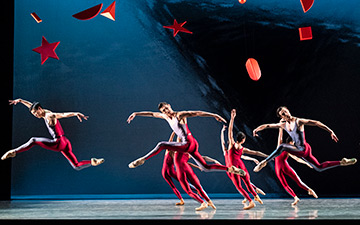
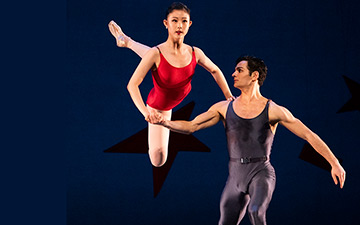
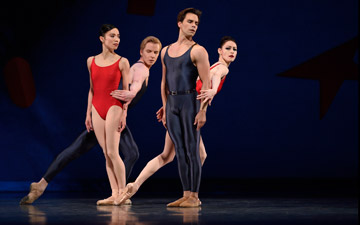

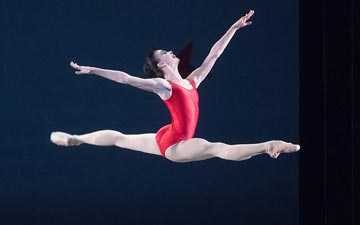
That is Diego Cruz, and not Joseph Walsh, in the photograph with Dores Andre.
Another correction on the photograph, upon even closer look: it is Diego Cruz and Julia Rowe.
Duh – thanks for letting us know and all corrected now. BM, Ed
Terrific review !!!!